| Shortcuts to different sections | ||||
| Re-use | Special Staff | Liverpool Roller | Truro Crown ? | Glasgow |
These are usually on a quite narrow range of plates. Langmead & Huggins have a section 'Other Telegraphic Cancellations' on page 45.
It shows the P.P.12 cancel (usually in pairs) on 1s stamps (The first here is courtesy of Devlan Kruck, next is from Andrew Higson). The 3d is unusually clear (courtesy of Michael Driver).


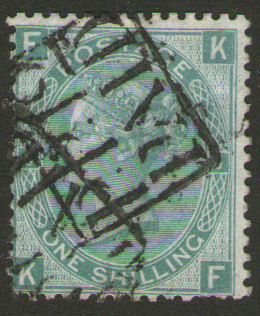
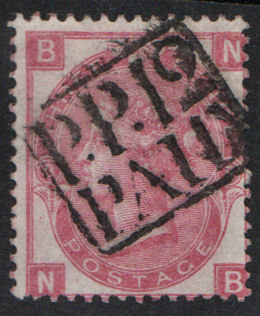
There are other examples of obsolete cancellers being re-used for telegraphic purposes however,
such as the Barred Oval 38 below :
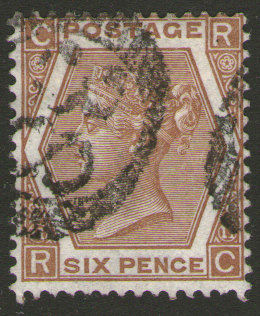
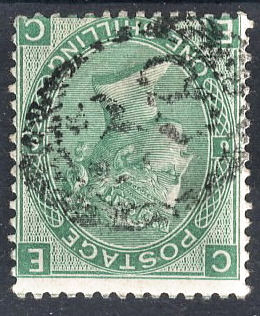
This was used for postal purposes in Kensington from 1844 until early 1850's, but then apparently brought back into use for telegraphic purposes in the early 1870's.
The 1/- is courtesy of Ian Pinwill, the 6d is one of the few stamps I have ever bought from S.G. who apparently didn't recognise the cancel that they list ![]()
Another that they should illustrate is the No.1B shown on the 1s below :
The cancels on these are of variable clarity, but virtually all are from the 1s plate 6.
Then there is the 'Seven 8-Segmented Concentric Rings' of the British & Irish Telegraph Company Limited.
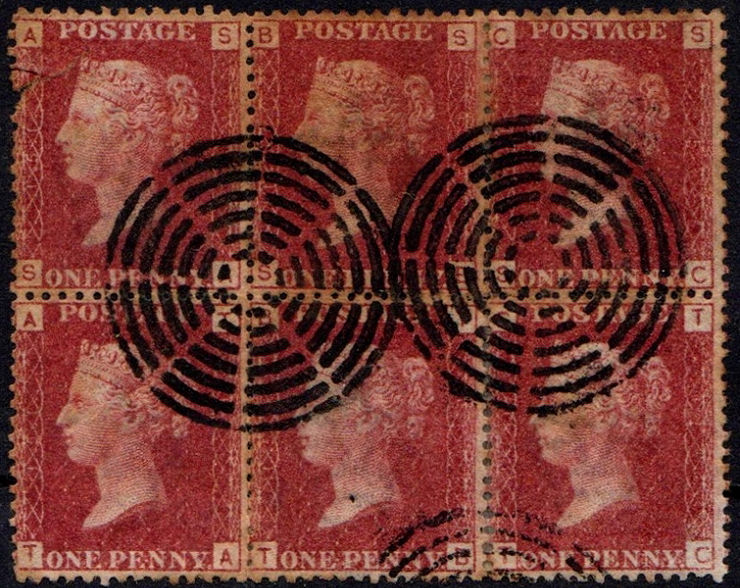
Block of six 1d plate 151 courtesy of Michael Driver.
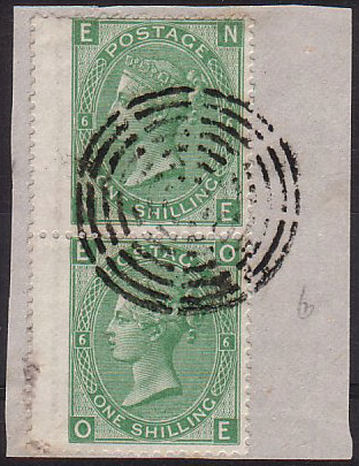 |
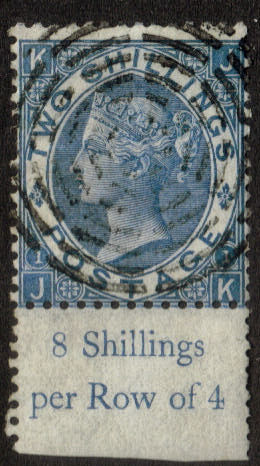 |
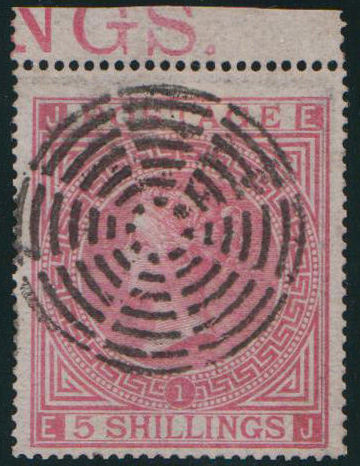 |
| 1s plate 6, unknown Origin. | 2s, courtesy of Dave Lewis. | 5s, courtesy of Paul Ramsay. |
| With dates approximate, I have seen these on: 1d plate 151 (printed 14/11/71 to 2/4/74) 3d plate 6 (printed 22/6/69 to 14/5/72) 3d plate 7 (printed 19/10/71 to 29/2/72) 3d plate 8 (printed 29/2/72 to 29/11/72) not seen on plate 9 (put to press 31/6/72) 6d plate 8 (printed 8/3/69 to 3/5/70) 6d plate 9 (printed 3/5/70 to 6/3/72) 6d plate 11 buff (printed Oct. 1872 to 29/11/72) not seen on plate 12 (put to press 30/10/72) 9d plate 4 (spray, printed 3/10/67 to 1877) 1s plate 4 (spray, printed 13/7/67 to 23/12/70) 1s plate 5 (printed 20/2/71 to 30/9/72 1s plate 6 (printed 20/3/72 to 15/10/72) not seen on plate 7 (put to press 11/11/72) 2s plate 1 (blue, printed 10/4/67 to June 1867) not seen on brown, 27/2/80. 5s plate 1 (printed 18/4/67 to 28/3/74) not seen on plate 2 (put to press 25/3/74) |
The commonest would seem to be the 1/- followed by the 5/- and the 2/-. Other values are rather scarce.
Indications are that this cancel was used from the Post Office takeover until early 1872.
I would be interested if anyone has it on the 3d plate 9, 6d plate 12 or 1s plate 7.
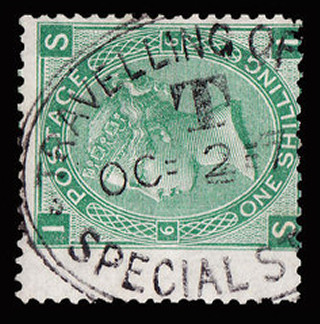
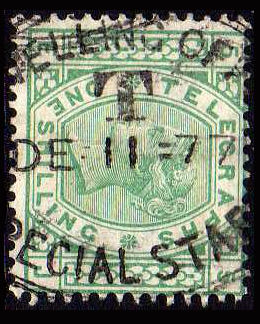
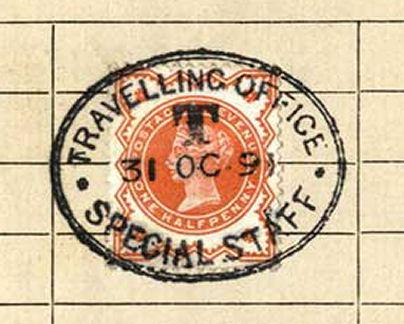
Travelling Office / Special Staff' dated Oct/2/72 (presumably) on 1s plate 6, together with 1s Telegraph plate 5 (Source: Andrew Higson).
The last items shows the complete strike. It and another are on a complete form (click on it to see). Very unusual and courtesy of Grosvenor Auctions.
Ian Pinwill is of the opinion that the 'Travelling Office' relates to the mobile travelling telegraph office introduced March 1872.
This was a horse-drawn vehicle, transported around the country by train, to cover important sporting or other events that needed it. These cancels were then used by its' staff.
The cancel on the one below-left has the same date as the left one above and, judging by the centring the stamp may
well have been from the same sheet.
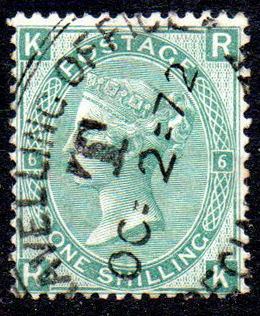 |
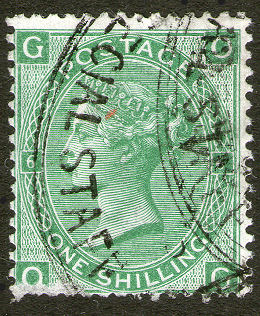 |
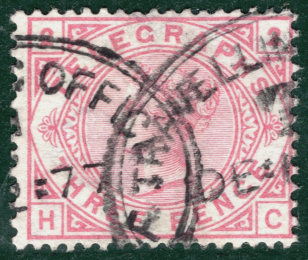 |
| Image courtesy, George Harrod of HIB Stamps. | This one, again on plate 6 does not show the date. | Another Dec. 1877, but on a 3d. Courtesy Samwells Ltd. click image for eBay listing. |
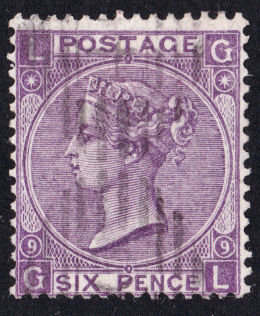
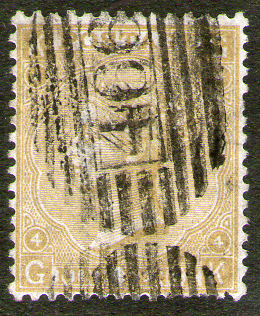
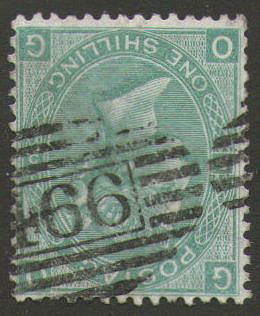
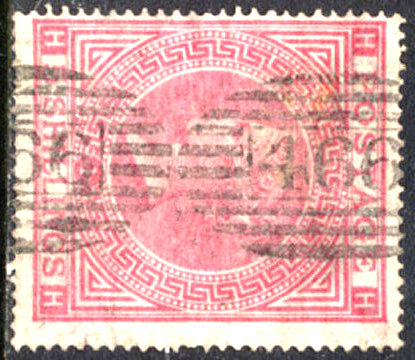
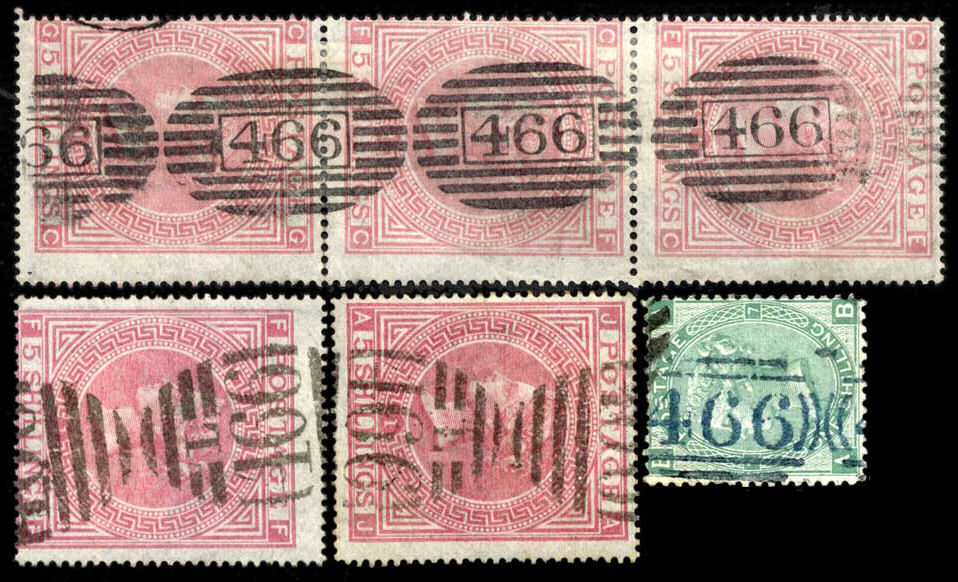
The bottom images courtesy of Grosvenor Auctions. There are at least 3 types of 'Liverpool Rollers'.
The 1s stamps at the top are both plate 5, whereas the one at the bottom is plate 7, so that roller may be a later type.
In British Postmarks - a Short History and Guide, R. C. Alcock and F. C. Holland (1960), page 81 referring to Fig.304 (A & H No.1087) shows the 'Liverpool Roller' and considers it to be 'mainly telegraphic'.
Langmead & Huggins in the section 'Other Telegraphic Cancellations' page 45 list other cancellations as being telegraphic but not this.
I have seen these now on 3d, 6d, 9d, 1s, 2s and 5s values, but mostly 5s plate 1. This is a bit 'top-heavy' for normal telegraphic use,
Here is further evidence with this 5s example from Andrew Higson FRPSL.
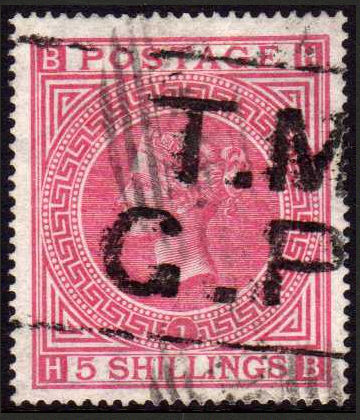
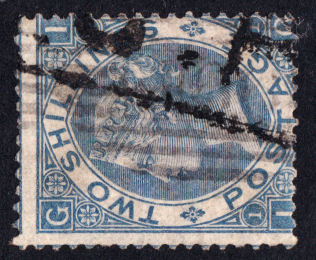
The 5/- stamp has a clear T.M.B (Telegraph Message Branch) cancellation
together with a (not so clear) Liverpool 466 Roller Cancellation.
This indicates the stamp was used for telegraphic purposes.
The additional 2s of mine, though not too clear adds further evidence.
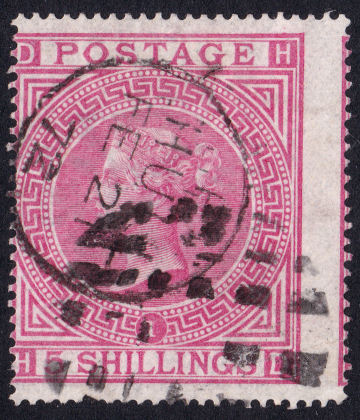
A nice neat 1872 CDS on a high value stamp is most likely telegraphic.
But what of the dumb cancel ? By association it is also likely to be telegraphic.
 |
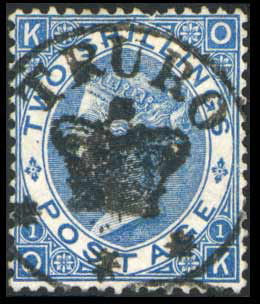 |
 |
| Illustrations courtesy of Grosvenor Auctions. | Source Andrew Higson. The May 2017 list of Steve Allen offers this at £1200. Lot 43 |
|
This is a scarce marking that is not recorded on cover.
F. Hugh Vallancey (British Postmarks, 2nd Edn. 1950 Pg.32) says
"Probably intended for telegraphic purposes but apparently used also for Postal cancellation."
Bob Galland and Karl Louis conducted a survey of stamps bearing this marking. The results were reported in the GB Journal (2008) Vol.46, No.6 pages 139 to 141.
I will tabulate here some of the findings:
As always there are many ways to interpret statistics.
For example if we consider the multiples to represent a single 'stamp' we get :
One last point, if we consider that these may have been the products of telegraphic usage, then these should all have been destroyed along with the forms they were on.
'Liberating' them would have been a risky endeavour reserved for the rarer items. 'Common' single one shilling stamps may have been passed-over in favour of the more exotic, thus inverting the statistics.
How many collectors keep their junk mail for future generations? Future researchers may consider them scarce items!
Two more scarce types that it has been suggested may have been telegraphic at least some of the time.
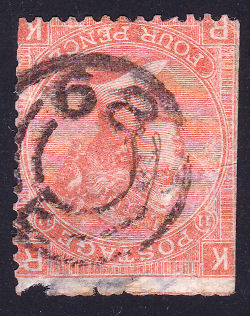 |
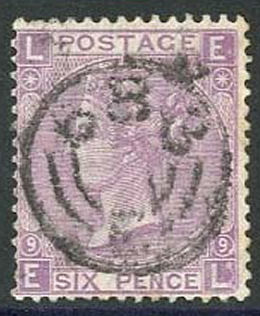
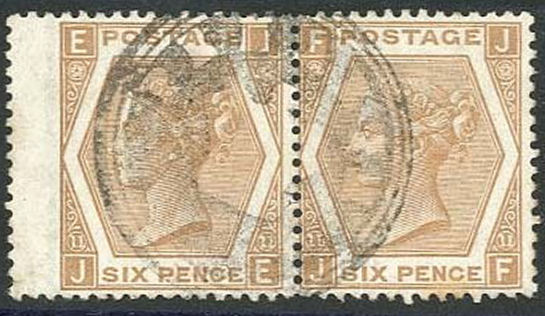 |
| One of mine | Ex. Andrew Higson, courtesy Spink & Son. |
The experimental type used at Salisbury (683) originally had four perforating pins in the middle which were later removed. Presumably the experiment was not a success, but what happened to the handstmap then?
The negative type with a crown in the middle is usually referred to as a "Mail-bag Seal Cancel". They seem to have been used for many things, a bit like inspectors marks. Some could have seen telegraphic use.
This is an unusual item, the vendor described it as a Telegraphic cancel, but I don't know.
2s6d is unusual for Telegraphic although it looks like other stamps were involved. Anyone recognise this?
Illustration courtesy of Grosvenor Auctions.
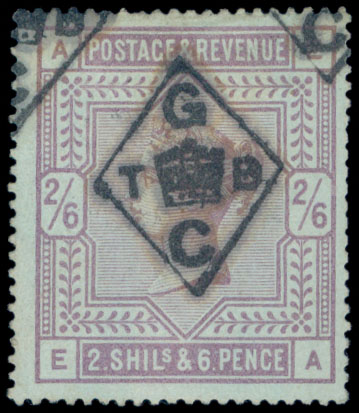
I now have confirmation that this is indeed Telegraphic.
It was one of a batch of 16 cancellers sent to the Telegraph Branch on 10 February 1871.
Of the 16, 8 of them were virtually identical to this. The other 8 were similar in that they had a central crown, T and B horizontally,
Another two letters vertically on 6 of them , LC without frame, PN rectangular frame, SR in a red-Cross type frame, RR in a circular frame, SD in a 4-pointed star and
PW (Private Wire) in what looks like the Ace of Clubs, but with 4 lobes. The remaining two have a single extra letter at the bottom, one like a tomb-stone with
a rounded top having an E, the other in a triangle having an I and the point at the top. I'm sorry for the description rather than an image,
but the source document is in a proof book, copyright BPMA and thus cannot be reproduced.
My thanks to Ian Pinwill who has recently spent many hours going through these books at the BPMA looking for Telegraphic cancels.
I still do not know for certain what the GC stands for, but since 8 copies of the hand-stamp were made, I presume that they needed them.
Ian Pinwill suggests that GC could stand for George Chetwynd who was Receiver and Accountant General, but it is only a guess.
The meaning of PW is known from a similar cancel but more squat and wide that was annotated "Sent to private wire Branch 6/10/70".
If only seen on postage stamps there would be no thought of this cancel being telegraphic..
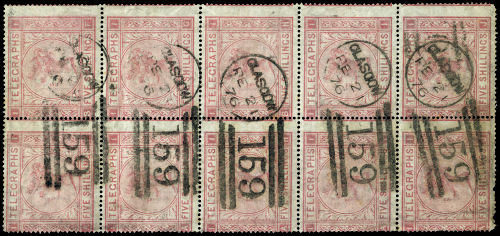 |
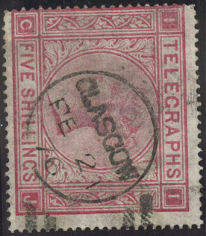 |
| This block courtesy of Grosvenor Auctions is lettered AF to BJ. Dated February 21, 1876. |
Stamp CJ was next to it. Courtesy of Ian Pinwill. |
Were they simply cancelled with the first thing that came to hand.
Clearly not a one-off accident.
This last is almost certainly postal use of the 3/- stamp, but I am really curious as to what this cancel signifies.
Anyone know anything about this cancel ?
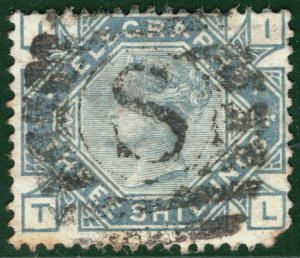
Said to be "ex Willcocks".
Image courtesy of Samwells Ltd.
click image for eBay listing.
Last updated 7th. November 2023
©Copyright Steve Panting 2012-23 except where stated.
Permission is hereby granted to copy material for which the copyright is owned by myself, on condition that any data is not altered and this website is given credit.